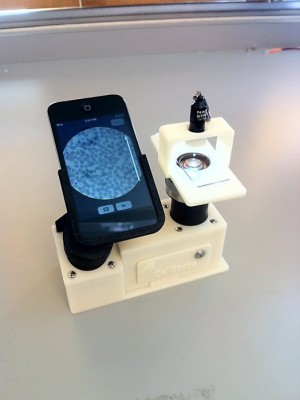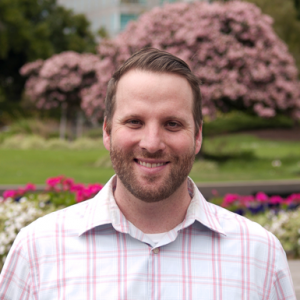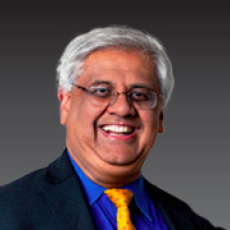By Tamara Straus
 Over the past year, UC Berkeley PhD student Zack Phillips and a team of six undergraduates assembled an LED array dome to fit on the Fletcher Lab’s CellScope microscope. The LED array did exactly what the team hoped for: it allowed the smartphone-enabled device to function as three separate microscopes.
Over the past year, UC Berkeley PhD student Zack Phillips and a team of six undergraduates assembled an LED array dome to fit on the Fletcher Lab’s CellScope microscope. The LED array did exactly what the team hoped for: it allowed the smartphone-enabled device to function as three separate microscopes.
Phillips, who works with Assistant Professor Laura Waller in the Computational Imaging Lab, notes that the adapted device is still too fragile to be field tested for tropical diseases. But he is willing to admit that his team’s youthful composition and the speed of their invention are impressive. Phillip’s research group consists mostly of 19- and 20-year-olds and they completed their project in about 800 hours. The team’s next step is to take their $1,000 version—combining the imaging power of three $10,000 microscopes—and turn it into something sturdier that eventually can be priced for clinicians in developing countries at around $500 (not including the cost of the smartphone).
Professor Waller is certainly proud of this young team’s latest innovation. Yet she underscores that her research group and many others in the Department of Electrical Engineering and Computer Sciences have plenty of accessible projects for undergraduate students and that plenty of undergraduate students are making valuable research contributions.
In the case of the Cellscope project, supported by the Blum Center’s Development Impact Lab, it has offered undergraduates the chance to tinker with Arduinos—an open-source prototyping platform based on easy-to-use hardware and software—that are often taught in high school. Other reasons for increased undergraduate involvement and research contributions, says Waller, include: the “maker movement,” which has popularized lab invention, and the affordability of 3D printers, which allow research groups to iterate new versions in a matter of hours.
“It’s totally different now that when I was an undergraduate,” says Waller. “There were 3D printers then, but now we have access to them.”
Waller points out that college student research contributions are also due to a general attitude about the reciprocal nature of undergraduates in university research. Both sides have something to gain—professors gain engaged college students and students gain a useful learning experience.
“Research is a really nice way for undergraduates to understand the real-world application of their skills and operate in an environment that’s a little bit more like a real job,” says Waller. “It’s a fantastic supplement to their formal education that will serve them better in their future careers.”
This is true not only for the College of Engineering but also for departments across campus. According to Stefanie Ebeling, who runs Cal’s Undergraduate Research Apprentice Program (URAP), founded in 1991, there is “definitely an upward trend” in undergraduate participation in faculty research. Ebeling said that there were 550 participating students in the fall of 2005; 935 in 2010; and this fall, there are 1,250 undergraduate research apprenticeships.
URAP was founded several years before the Boyer Report, which was published in 1998 by a commission of educators sponsored by the Carnegie Foundation and chaired by its president Ernest L. Boyer. Entitled Reinventing Undergraduate Education: A Blueprint for America’s Research Universities, the report argued that undergraduates at large research universities were often inadequately taught, due in large part to high student/faculty ratios, a predominance of lecture-based courses, and the demands on faculty besides teaching. The Commission argued that research universities should not try to emulate the teaching practices of small liberal arts colleges, but should take advantage of their research-related resources, integrating undergraduate education into the pursuits of graduate students, postdoctoral researchers, and faculty.
In the Commission’s words: “…Undergraduates can become junior members of the research teams that now engage professors and graduate students.”
In a November 2013 Center for Studies in Higher Education paper following up on the progress of the Boyer Report recommendations, authors John Aubrey Douglass from UC Berkeley and Chun-Mei Zhao from Stanford summarized the findings of 2010 Student Experience in the Research University (SERU) undergraduate survey, which was administered at all nine UC campuses and six top-25 public national universities.
Among the 130,000 students who answered the survey questions, most (81.3 percent) conducted research as part of a class assignment, such as a research paper—with 40.3 percent assisting faculty in research with or without pay and course credit. Douglass and Zhao found that assisting research faculty is more prevalent in the STEM fields, while independent and personal research is more likely in the humanities, social sciences, and professional majors.
The two authors also found that undergraduate research engagement “leads to self-reported learning gains across many areas, but especially in the areas of field knowledge, how to present and communicate knowledge, research skills, higher levels of satisfaction, better use of time, and higher levels of non-quantitative skills.”
“I think there are some clear reasons why everyone on campus—from students, to faculty, to administrators, to parents—has growing excitement for undergraduate research,” says Sean Burns, director of the UC Berkeley Office of Undergraduate Research & Scholarships. “On one hand, research opportunities give undergraduates a chance to freely pursue their interests and passions. In this sense, research can epitomize the beauty of liberal education. On the other hand, engaging in research—both in terms of skill building and in terms of knowledge produced—turns out to be one of the most pragmatically beneficial choices an undergraduate can make. What employer or graduate school isn’t thrilled to hear a student speak of their research accomplishments?”
On October 1, 2015, Burns organized an Undergraduate Research Fair that brought together about 400 students and faculty, including Randy Schekman, who won a 2014 Nobel Prize in Physiology or Medicine and regularly employs undergraduates in his cell biology research lab. Burns said the event attracted a large number of first and second year students from the STEM fields, but there were a decent of students from social science and other disciplines as well.
Brandie Nonnecke, a research and development manager at the Center for Information Technology Research in the Interest of Society (CITRIS), agrees that STEM students, and particularly computer science students, are in demand at her and other university labs. But she also notes that many of today’s undergraduates are by nature problem solvers and tinkerers.
“They’re being called the Benjamin Franklin Generation,” says Nonnecke. “They’re not afraid of a challenge, and I think they gain a lot of joy in getting hands-on experience.”
Nonnecke says that on CITRIS’ CAFÉ project, an open source, e-participation platform on social and political issues, undergraduates have been instrumental in building the platform. Currently, the CAFÉ team employs six undergraduate students and two Industrial Engineering and Operations Research graduate students.
Aditya Gande, a third year Electrical Engineering and Computer Sciences student who worked on the CellScope in Professor Waller’s lab in 2014 and 2015, explains he sought out a research opportunity because he considers it the best way to get experience outside classwork during the school year.
“A lot of people do their own projects,” says Gande, “but I thought I’d go for lab work, because it’s a little more structured and prestigious. Also, from a job perspective, it’s really difficult to add onto your resume if you’re not doing research.”
Gande, a Regents Scholar, has been thinking along these pragmatic lines since he was a teenager. While a junior in high school, the Cupertino resident landed a lab position at Stanford, making a basic android app for Assistant Bioengineering Professor Manu Prakash Lab’s Oscan device, a cell phone-enabled scanning tool for the mouth. Gande then went on to create open source software for 3D image modeling on 2D images. And in his senior year, he analyzed images of beetles to get their flight data.
Although Gande doesn’t plan to get a PhD, he does intend to continue his research career at a medical device startup.
“I don’t want to indulge myself and waste my youth working on social media apps or something like that,” he explains. “I feel medical devices are more impactful, even though they take longer and require much more effort. Low-cost health is important everywhere.”
As for whether it’s difficult to find research opportunities on campus, even for students without computer science skills, Gande has this to say: “Berkeley is a research university. Anyone who says they can’t find opportunities doesn’t know what they’re talking about.”





